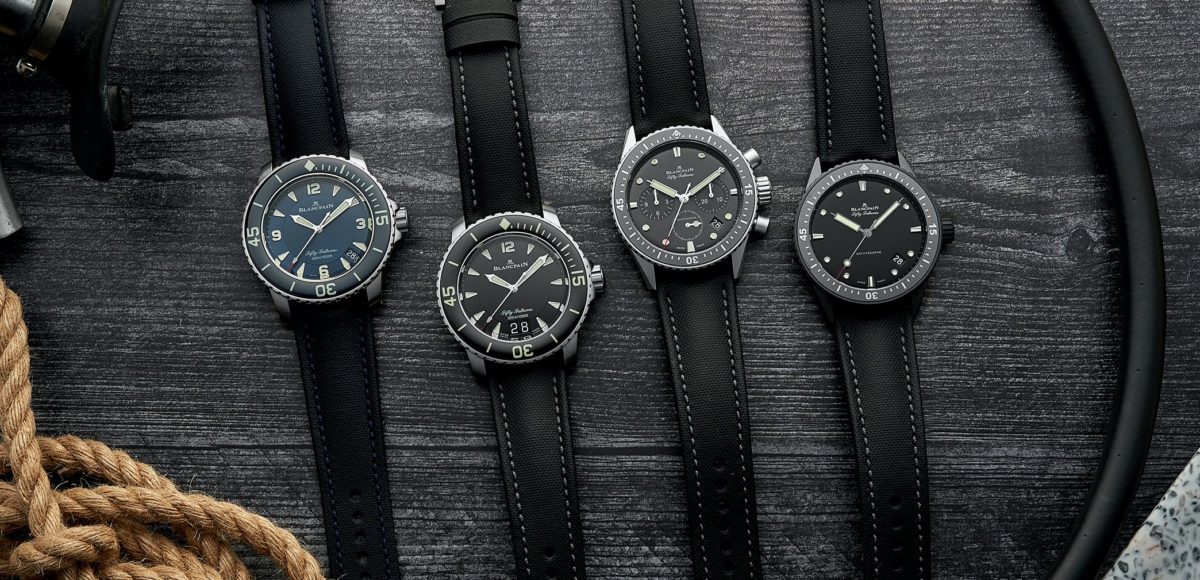Originally Posted on Hodinkee March 3, 2020
Blancpain, with roots dating back to 1735, is a company that brings the perspective of generations to its watchmaking. The brand is often uncredited for the key role it played during the revival of the Swiss watch industry in the 1980s and ’90s, and it is equally unheralded for its position as a movement supplier to some of the most prestigious Swiss marques for decades. Today, Blancpain resides in the highest echelon of the Swatch Group, and it is perhaps best known among contemporary enthusiasts for the Fifty Fathoms, an expansive collection of timepieces that traces its origin to the early 1950s, during the foundational years of professional and amateur diving.
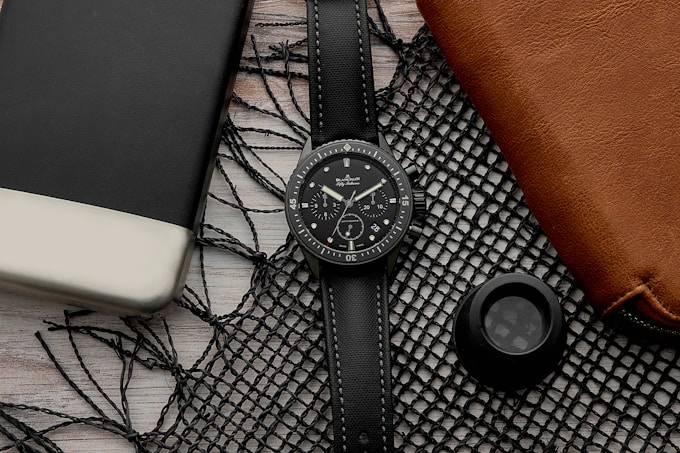
With the 1953 debut of the Fifty Fathoms, Blancpain was one of the pioneers in developing what a modern dive watch should look like. Its design and technical principles helped lay the groundwork for the ISO 6425 standard, the specifications that today govern whether or not a watch is suitable for professional diving. It is because of Blancpain’s status as a trailblazer in dive watch production that we collaborated with the firm on the Fifty Fathoms Bathyscaphe Limited Edition for HODINKEE last summer. And it’s why we’re thrilled to announce that, as of today, the HODINKEE Shop is an authorized retailer for the brand. You can explore our curated selection of Blancpain timepieces right here, all of which come from the greater Fifty Fathoms collection, or read on to learn more about the original development of the Fifty Fathoms and how Blancpain has continued to improve it in the 21st century.

Why Blancpain? Why Fifty Fathoms?
There are very few absolutes in the watch industry, but one unconditional truth is the overwhelming popularity of the dive watch. The number of brands without a contender in the genre are few and far between, and the factors that are so appreciated in the category can be attributed to the ingenuity of Jean-Jacques Fiechter, the co-CEO of Blancpain from 1950 to 1980, and the requirements of the French Navy’s Nageurs de combat division. The characteristics of that first Fifty Fathoms included a guaranteed water resistance of 91.45 meters (the maximum depth a diver could achieve at the time), a unidirectional timing bezel, automatic winding, a high degree of legibility with clear luminous markings, antimagnetic protection, and a general robustness that could stand up to abuse on land or at sea.
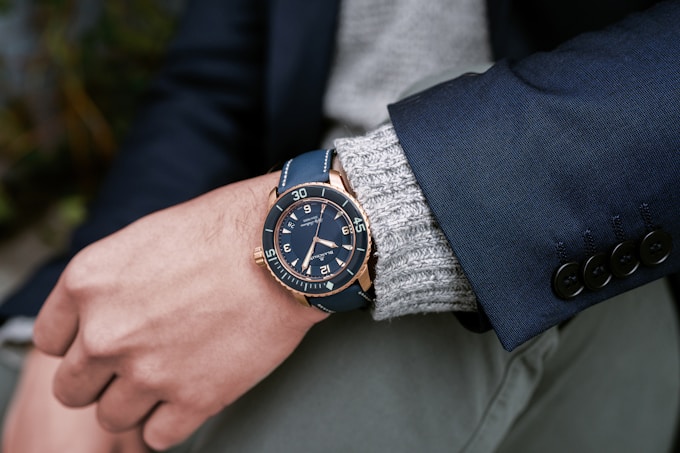
Fiechter was a diving enthusiast when the sport was in its infancy, and it was a dive off the coast of France in the early 1950s that prompted him to begin formulating ideas for a professional-grade dive watch. Fascinated with the underwater world, Fiechter lost track of his time underwater during that fateful dive, requiring an immediate ascent to the surface without a decompression stop, leaving him at the risk of “the bends.” This incident was the impetus for Fiechter’s realization that, alongside crucial gear like masks and oxygen tanks, mid-century divers needed an instrument to indicate elapsed time while underwater.
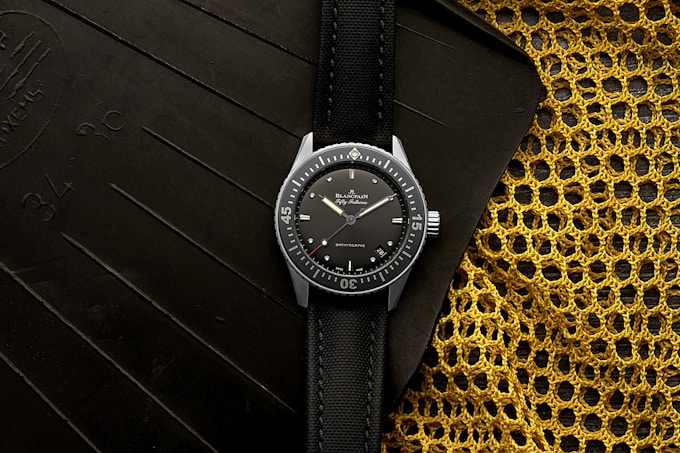
Thanks to his position at Blancpain, Fiechter was able to begin experimenting with what would, unbeknownst to him at the time, become the key components of all future dive watches. Chronographs were unable to be used underwater at this point in watchmaking history, so Fiechter developed an exterior, unidirectional bezel with time markings, which could be used to track the amount of time spent underwater. Fiechter also experimented with the placement of gaskets inside the caseback and in the grooves of the crown to seal the watch from the intrusion of water despite constant pressure. Fiechter quickly realized that his ideal watch would also require an automatic movement, as manually winding a crown would wear down the crown gasket over time. Watches with some degree of water resistance were already available on the market by the 1950s, but it wasn’t until Fiechter considered what attributes would be the most beneficial for professional diving purposes, that the format of the modern dive watch was officially established. The result was a shift in perspective, not only with respect to how a watch could best function underwater, but also to the design of sports watches as a whole.
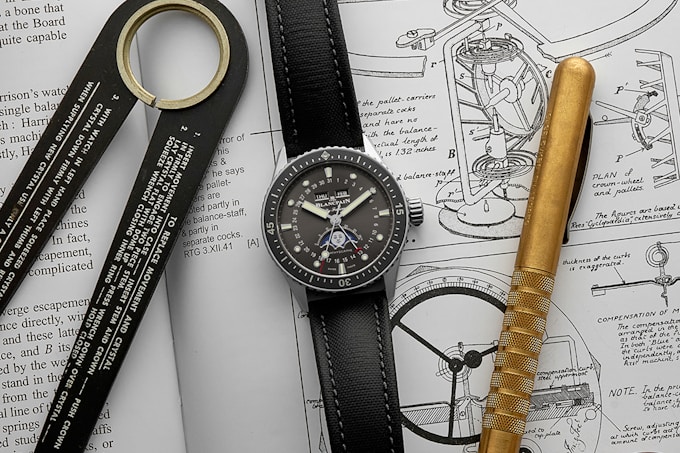
As Blancpain and Fiechter continued the watch’s development, a prominent dive equipment manufacturer named Spirotechnique (later Aqua Lung) put Fiechter in contact with Captain Robert Maloubier and Lieutenant Claude Riffaud of France’s premier maritime special operations unit, the Nageurs de combat. Maloubier and Riffaud required a watch that could be trusted during extreme underwater situations, leading them to Blancpain and the first professional application of the Fifty Fathoms. Maloubier had one additional request for the Fifty Fathoms, which involved placing a soft iron shield between the movement and caseback to protect the timekeeping from the effects of magnetism. The rest is history, and the Israeli, Spanish, German, and U.S. navies followed the Nageurs de combat in the professional use of the Fifty Fathoms, with each outfit requiring slight changes to match each country’s specification standard.

Spirotechnique/Aqua Lung also helped the Fifty Fathoms capture the attention of who would ultimately be its most famous ambassador, Jacques-Yves Cousteau, who trusted the watch on his wrist while filming The Silent World, an award-winning 1956 documentary that introduced the underwater world to millions more people. Diving had officially hit the mainstream, and Blancpain’s Fifty Fathoms was right in the center of the action. The Fifty Fathoms soon became de rigueur for any organization or person serious about diving or exploring the ocean. Blancpain released a smaller diameter version of the Fifty Fathoms in 1956, named the Bathyscaphe, in order to reach a larger audience of amateur divers as the sport of scuba diving rapidly grew in popularity.

The Blancpain Fifty Fathoms held a pivotal role in the early years of underwater exploration, and its contemporary collection pays tribute to the original in a number of ways. Where the Fifty Fathoms operated as a straightforward tool watch in the 1950s, Blancpain is able to apply its haute horlogerie expertise to the watch today, resulting in the use of precious and unconventional metals, fine complications, and a superlative level of handcraft that sets it apart from any other dive watch maker on the market.
The Blancpain Fifty Fathoms, With More Variety Than Ever Before
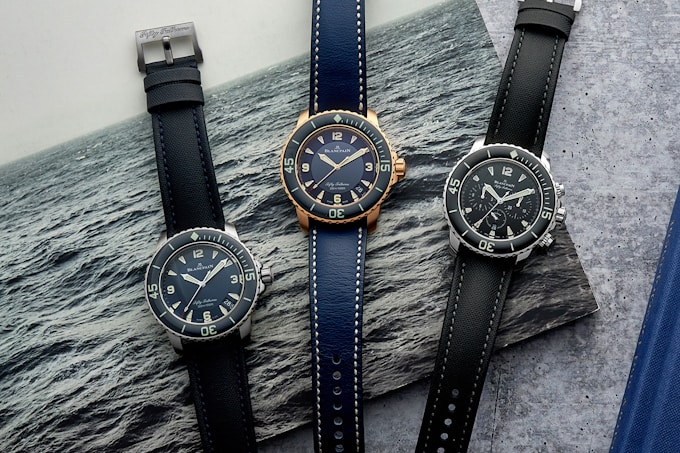
There isn’t a definitive estimate on how many variations of the Fifty Fathoms were created during Fiechter’s time at the helm of Blancpain, but there is zero doubt that the current Fifty Fathoms collection is more diverse and accessible than at any other point in its history. This is impressive, considering the contemporary line has only been a permanent part of Blancpain’s catalog since 2007. During the aftermath of the Quartz Crisis in the 1980s and ’90s, Blancpain instead prioritized the production of highly complicated dress watches housed in precious metals, often incorporating a moon-phase display, in order to entice back consumers who had gravitated toward the go-anywhere, do-anything nature of quartz-based timekeeping.
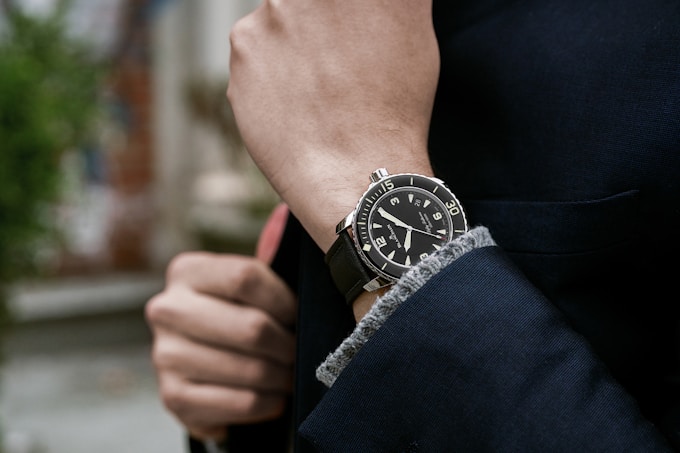
It wasn’t until 2003, when Fiechter’s creation celebrated its 50th anniversary, that the Fifty Fathoms returned to a place of prominence in Blancpain’s line-up. Under the guidance of CEO Marc Hayek, a lifelong diver himself, the Fifty Fathoms was offered in a limited edition release of 150 pieces, all of which promptly sold out. Prior to that release, the Fifty Fathoms had only made minor appearances in the greater Blancpain catalog in 1997 and 1999, after the watch’s original run ended in the late 1970s. Based on the success of the 2003 launch, Blancpain spent four years developing an entire Fifty Fathoms collection, which finally made its debut in 2007. It’s this announcement that has guided the Fifty Fathoms, as we know it today, ever since.
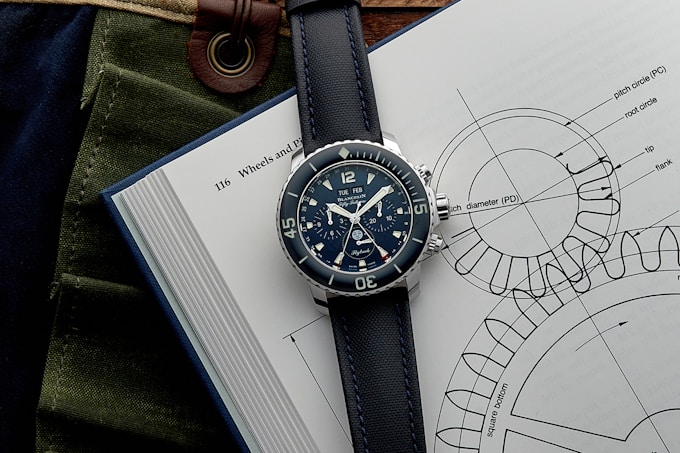
The 2007 Fifty Fathoms collection introduced a few elements critical to how the watch is viewed by collectors today. The overall look is directly influenced by the 1953 Fifty Fathoms, but it’s updated for the 21st century with sword hands, an intermix of Arabic numerals and triangular hour markers filled with Super-LumiNova, curved lugs, and consistent dimensions, regardless of complication, of 45mm. The bezel is uniquely curved and features an insert made of sapphire crystal, a material as famed for its scratch resistance (with a nine on the Mohs scale of hardness, few other materials are more resilient to damage) as it is for the difficulties surrounding its serial production. The date placement is mostly consistent throughout the contemporary Fifty Fathoms, positioned between four and five o’clock on the dial in a color-matched aperture. This location is intentional, as it doesn’t obstruct any hour markers, a crucial detail when keeping track of dive time.
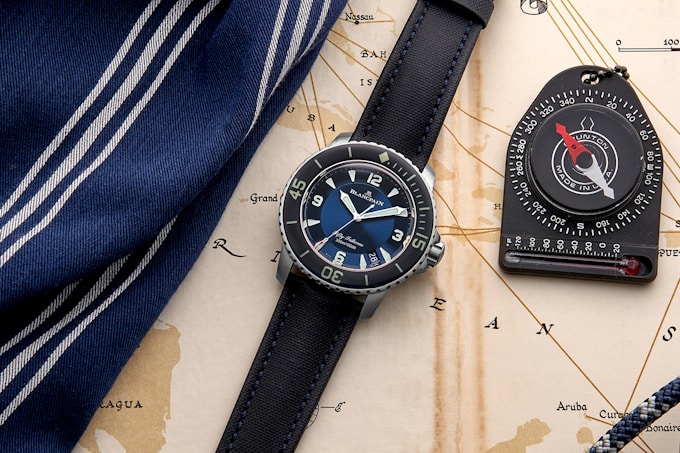
Blancpain has expanded its core Fifty Fathoms collection in a number of directions since 2007, with a wide variety of case metals and complications now available. We’re excited to welcome seven different watches from the core Fifty Fathoms collection to the HODINKEE Shop today, from time-only models in steel, titanium, and red gold to highly complicated pieces featuring flyback chronographs and complex calendars, and even some with a combination of the two.
In addition to the standard Fifty Fathoms, one of the directions Blancpain has developed the line in since its 2007 rebirth is through the Bathyscaphe, a sub-collection of timepieces with historical precedent that offer a different take on the iconic dive watch.
The Blancpain Fifty Fathoms Bathyscaphe
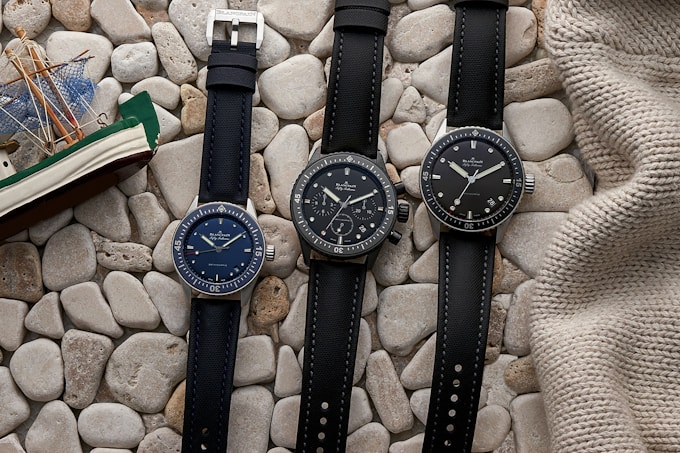
The Bathyscaphe, named after the deep-diving submersible invented by Swiss physicist and explorer Auguste Piccard, was introduced in 1956 as the civilian complement to the more professionally minded Fifty Fathoms. The original Bathyscaphe came in a smaller size than the more substantial Fifty Fathoms and was targeted toward the recreational diving market. Blancpain continued to build out its Fifty Fathoms line on the occasion of the 60th anniversary of the original watch in 2013, with an entire series of Bathyscaphes. These watches maintained the core conceit of the original Bathyscaphe, with a smaller diameter and more accessible price point, despite no loss in technical proficiency or professional specification.
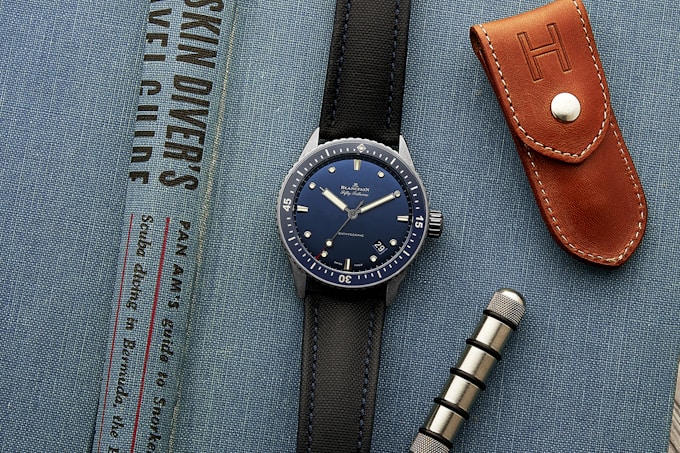
The overall design of the contemporary Bathyscaphe offers a cleaner and more subdued look than its larger sibling. It’s most identifiable through details like the thin and flat bezel profile, fitted with a ceramic insert and Liquidmetal markers and numerals as well as a focus on more matte case finishes with beveled lugs. The watch’s diameter remains consistent at 43mm, regardless of the presence or absence of complications. It’s also much thinner than the standard Fifty Fathoms. The dials used in the Bathyscaphe are comprised of small hour markers filled with Super-LumiNova, bar-shaped hour and minute hands, and red-tipped seconds hands. The Bathyscaphe has seen a number of iterations since its 2013 inception, and Blancpain has continued to develop it with a number of case metals, including various ceramic colorways, and new complications like flyback chronographs and Blancpain’s signature combination of a complete calendar with moon-phase indication.

The Movements Inside The Fifty Fathoms Collection
Blancpain is as well known today for its in-house movement production as it is historically for the Fifty Fathoms. The Swiss brand, which maintains two manufactures in Le Brassus and Le Sentier, in the Vallée de Joux, is one of Switzerland’s most vertically integrated watch companies. Blancpain benefits from its historic relationship with renowned movement manufacture Frédéric Piguet, which has been fully integrated into Blancpain since 2010, but has operated as the company’s manufacturing subsidiary for decades. As Blancpain has returned to the greater Fifty Fathoms collection over the past decade-plus, it has used various Fifty Fathoms and Bathyscaphe models as platforms for new movement designs. Two of these stand out in particular: Caliber 1315, first used in the Fifty Fathoms Automatique in 2007, and Caliber F385, launched within the Bathyscaphe Flyback Chronograph in 2014. Both movements are automatic, in keeping with Fiechter’s requirement of the original Fifty Fathoms, and were constructed and developed entirely in-house.

Caliber 1315, used in the standard three-handers in both the Fifty Fathoms and Bathyscaphe lines, combines haute horlogerie detailing and finish with features that benefit the Fifty Fathom’s tool watch background. One of the most impressive aspects of this movement is its 120-hour (or five-day) power reserve, which is the result of three series-coupled mainspring barrels. Blancpain was an early adopter of silicon technology, and caliber 1315’s balance spring is made of the high-tech material. The use of a silicon balance spring allows for a number of advantages, including improved shock resistance and enhanced resistance to the effects of magnetism. That last factor is key for the Fifty Fathoms, as one of the original watch’s distinguishing features was the presence of a soft iron case shield. Because the silicon balance negates the influence of magnetism on chronometric performance, Blancpain is able to incorporate a sapphire crystal exhibition caseback, allowing a full view of caliber 1315. The free-sprung balance wheel of caliber 1315 is made of Glucydur, and it features no index or swan’s neck regulation. Instead, the rim of the balance is set with four square-shaped gold regulation screws. These screws help mitigate any shocks and improve rate stability. Each watch in the Fifty Fathoms collection has an 18k gold rotor that, in most models, has undergone an application of NAC, a platinum alloy, resulting in a blackened finish that is then sandblasted for texture.
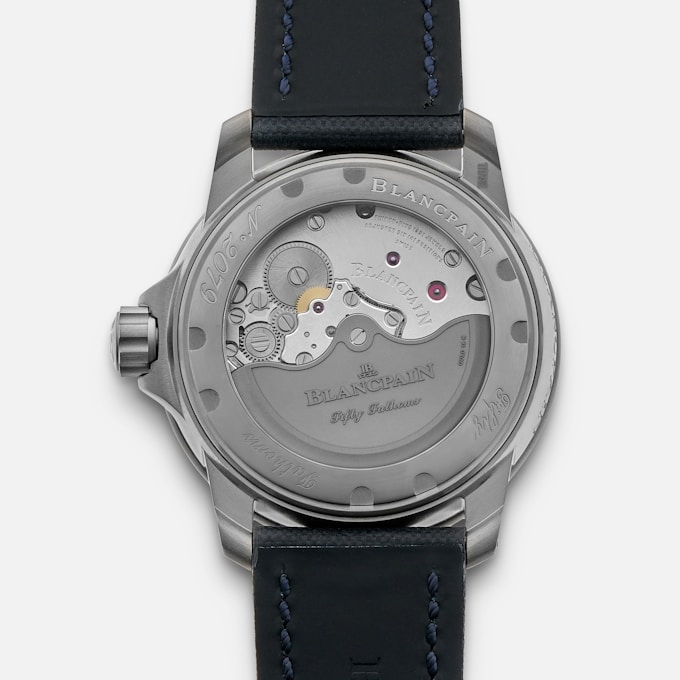
Blancpain automatic caliber 1315, found inside all of the Fifty Fathoms Automatique and time-only Bathyscaphe models.
Caliber F385, on the other hand, was quietly unveiled in 2014 and represented a significant step forward for Blancpain’s chronograph production. This flyback chronograph design contains a vertical clutch, a column wheel, and a high-beat frequency of 36,000 vph, or 5Hz, the first Blancpain movement to achieve this rate. The high frequency allows the chronograph to measure elapsed time up to 1/10th of a second and for greater precision over time due to the higher amplitude. Caliber F385 shares with caliber 1315 a free-sprung Glucydur balance wheel regulated by four gold screws and a silicon balance spring, allowing the presence of an exhibition caseback. With flyback functionality, caliber F385 can be reset and restarted by a single pusher without stopping the chronograph itself. The presence of a vertical clutch in caliber F385 guarantees the seamless start of the chronograph seconds, and the column wheel enables smooth actuation of the pushers. These are the kind of details found in truly high-end chronographs, and the F385 is one of the few serially produced modern calibers to incorporate every single one of them.
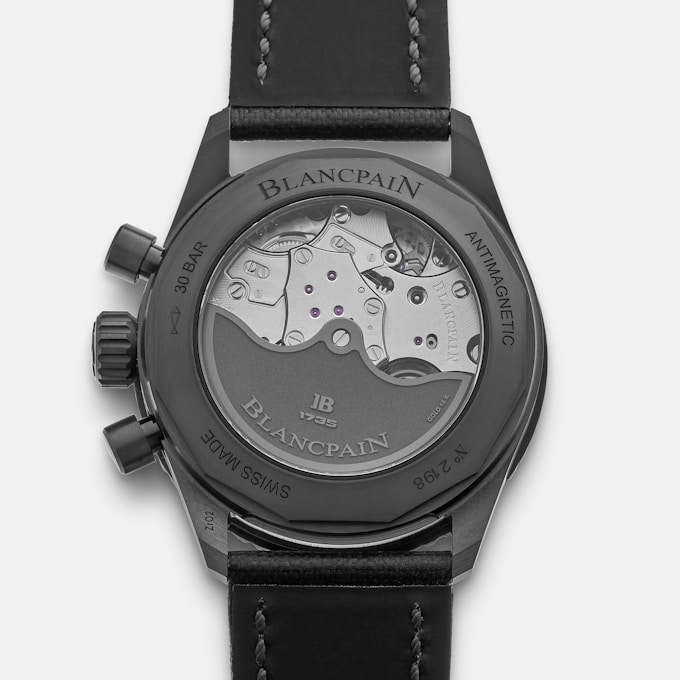
Blancpain automatic chronograph caliber F385, found inside the Bathyscaphe Flyback Chronograph models.
The finishing of caliber 1315 and caliber F385 is understated and refined. It isn’t over the top, yet it is indicative of Blancpain’s haute horlogerie capabilities. The most important elements in both calibers are the soleil, or sunburst, finish of the bridges and the precise anglage of the bevels. These elements give the movement design a certain level of prestige in keeping with Blancpain’s manufacture status, but don’t betray the Fifty Fathom’s tool watch origin.

More Blancpain In The HODINKEE Shop
With today’s announcement, the HODINKEE Shop is now the proud authorized retailer of 16 watch brands. Blancpain and the Fifty Fathoms bring an entirely new dimension to the HODINKEE Shop, one that combines heritage and craftsmanship with hard-wearing design. Whether you are a diver, simply curious about Blancpain’s role in the history of diving, or on the lookout for a luxury sports watch with some serious horological firepower behind it, the entire Fifty Fathoms collection is as versatile and outstanding an option as there is today.
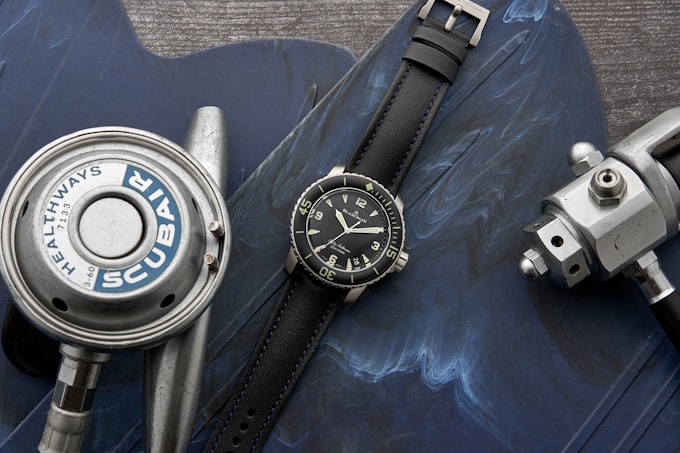
There are 15 different variants of the Fifty Fathoms and Bathyscaphe available right now in the HODINKEE Shop, and each of them includes the same convenience and added value we’ve always offered, including expedited worldwide shipping, digital paperwork storage, and an additional year’s warranty on top of the factory guarantee. You can take a closer look at the entire Blancpain Fifty Fathoms collection available right now in the HODINKEE Shop at our dedicated brand page.
Get More Articles Like This in Your Inbox
We're constantly creating great content like this. So, why not get it delivered directly to your inbox? By subscribing you agree to our Privacy Policy but you can unsubscribe at any time.





